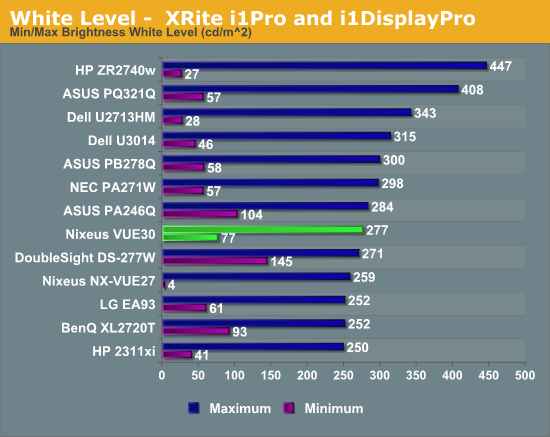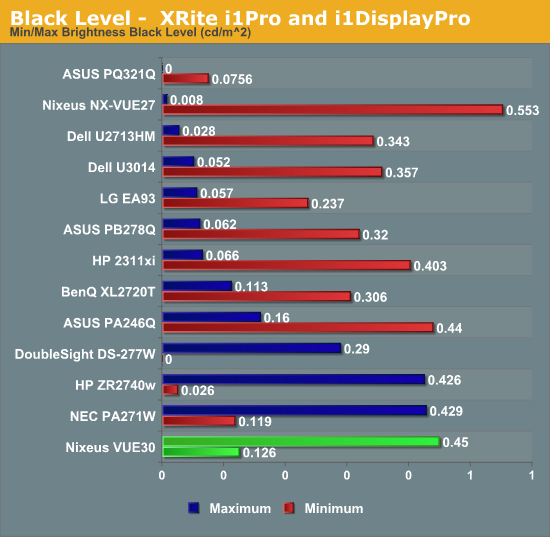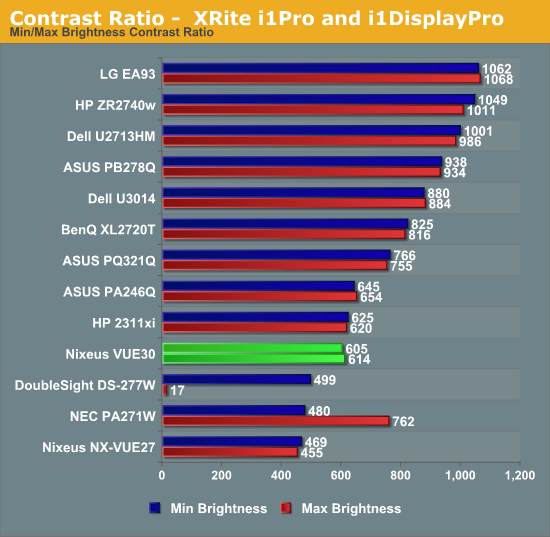Nixeus VUE 30: 30" 2560x1600 IPS Monitor Review
by Chris Heinonen on August 20, 2013 6:00 AM ESTIt seems that the larger the panel on a display I review, the brighter the display can get. I always expect the opposite, as lighting more screen would take more and more power. So far, that has not been the case. The VUE 30 is plenty bright, but not as blindingly bright as many other large displays. When I crank the brightness to maximum I measure 277 cd/m2 of brightness on a pure white screen. Moving the brightness to minimum drops this down to 77 cd/m2, which is below the 80 cd/m2 I like the minimum to fall under. This should provide plenty of range for most users.

With a black screen, we see a black level of 0.126 cd/m2 with the backlight at the minimum level. With the backlight to maximum this jumps up to 0.45 cd/m2. This level is very much in line with other computer monitors. I won’t fault Nixeus for this, but I’m always surprised at the level of black that is accepted with PC monitors that isn’t acceptable with TVs. Modern plasma displays can produce black levels of 0.006 cd/m2 under the same test conditions, and modern LCDs can hit 0.05 cd/m2 as well. I understand why plasma isn’t used for a PC display, but I’d like to see all vendors work on their black levels going forward. Basically, this panel seems similar to the 30" IPS displays we tested over five years ago; it's just half the price now.

These numbers provide us with a contrast ratio of just 610:1 on average. This falls well behind the Dell U3014 and ASUS PQ321Q displays, which are the most recently reviewed 30”+ displays I have data for. Those both cost a lot more, but being close to 600:1 is a disappointment to me.

With those basic measures out of the way, it was time to see how accurate the VUE 30 is.










95 Comments
View All Comments
1Angelreloaded - Thursday, August 22, 2013 - link
uhm how can I break this down for you Photography and Filmography are used professionally on these monitors so MS plays a huge roll in ghosting during the film, so yes it does matter considerably, and this day in age people hybrid their workstations so they can game and do pro work on them, hence Nvidia released the Titan to fill that market, 1k for a hybrid workstation/gaming card is amazing.purerice - Wednesday, August 21, 2013 - link
To rephrase what Sancus said, there are two types of customers for >27", >1440p monitors: those who need high refresh rates and those who need high color accuracy. The intended market for the VUE 30 is the high color accuracy market.Asmodian - Tuesday, August 20, 2013 - link
The now discontinued LG W3000H had low input lag due to the lack of OSD and only one input (DVI-DL). It also has a wide gamut and mine has an uncalibrated white point of around 9000K (due to extra green instead of blue). Odd how no one seems to care about input lag on 16:10 displays anymore. Only 16:9 for gaming I guess. :(rtho782 - Tuesday, August 20, 2013 - link
My Dell WFP3007-HC has almost no input lag. The advantage of having a 30" from the days before there were any image processing chips available for 2560x1600 :PSodaAnt - Tuesday, August 20, 2013 - link
I used a dell u3011 for quite a while, which I believe has similar input lag, and I never noticed a thing in gaming. I think its just another tiny lag, keep in mind it isn't even two frames at 60 fps, and if you're running at 30 fps its not even a single frame of lag, so I doubt most people would notice it in gaming.oobble - Wednesday, August 21, 2013 - link
That is completely untrue. Most 2560x1440 27" monitors have an input lag of around 7ms.blackoctagon - Thursday, August 22, 2013 - link
Was that a reply to me? If so then what you state is incorrect, or you otherwise are referring to input lag in a different form to me. What matters is TOTAL monitor latency (a product of 'input lag' as well as pixel response time and processing time). Total latency on most IPSs is not appropriate for fast motion shooters, even though there are a select few IPSs that have low input lag, or have high refresh rates. In any case, this Nixeus is not one of these select few and is appropriate for graphics/photo design work rather than gaming.AnnonymousCoward - Thursday, August 22, 2013 - link
I think the latest Dell 30" has a game mode with sub-16ms lag. This is critical to me for ALL computer usage.Soldier1969 - Friday, August 23, 2013 - link
Uhm spoken by someone that clearly can't afford one or never used one. Only read about them I guess. Ive been gaming on a HP ZR30 for 3 years now very happy with the clarity and shooting motion but thanks nice try.ZeDestructor - Tuesday, August 20, 2013 - link
Same range as on every top-end "professional-use" wide-gamut panel. My U2410s have similar, and my 2408 is far worse at 64ms overall. All of those are eminently good for gaming. If anything, I prefer them over any fast TN because of the nicer colours. Really helps immersion :D. Sucks a bit for online p,lay though, but until eDP-based panels become a major thing, we'll still have input lag from scalers and whatnot, and in any case, you can't go below the panel response.